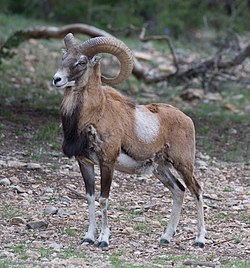Top Qs
Timeline
Chat
Perspective
Armenian mouflon
Subspecies of mammal From Wikipedia, the free encyclopedia
Remove ads
The Armenian mouflon[1] (Ovis orientalis gmelini) is an endangered subspecies of mouflon endemic to Iran, Armenia, Nakhchivan Autonomous Republic of Azerbaijan, Turkey and Iraq.[2]
Remove ads
Remove ads
Taxonomy
The Armenian mouflon was first described in 1840 by Edward Blyth, who equated it with the "Orientalische Schaaf" (Oriental sheep) described by Samuel Gottlieb Gmelin in 1774.[3][4][5]
It is known as the Armenian mouflon in both Armenian: հայկական մուֆլոն, haykakan muflon and Persian: قوچ ارمنی, Qutch-e armani.[6] Alternative names include Armenian wild sheep,[7][8] Armenian red sheep,[9] Transcaucasian mountain sheep,[10][11] Transcaucasian sheep.[12] and Anatolian mouflon.[2]
Remove ads
Distribution and population
In Iran, Armenian mouflons are found in the northwestern part of the country. Individuals were transferred to Kabudan Island in Lake Urmia in 1895 and 1906 by one of the governors of Iranian Azerbaijan.[13] A study carried out in the 1970s at the island found that their number declined from around 3,500 in 1970 to 1,000 in 1973.[7] In 2004 1,658 Armenian wild sheep were counted at the Angouran Protected Area in Iran's Zanjan Province.[14]
In Armenia, O. o. gmelini is found in Syunik Province (and to a lesser extent, in the provinces of Ararat and Vayots Dzor).[15][16] According to a 2009 study there were "hardly over 200" mouflons in Armenia.[17]
In Azerbaijan, an estimated 250 to 300 mouflons are found in the Nakhchivan Autonomous Republic.[18]
Remove ads
Habitat

The Armenian mouflon lives mostly in open rough terrain at medium or high altitudes, where they inhabit rocky hill country, lowland and highland steppes, rocky semideserts and, grass-covered slopes in the southern Caucasus region.[19] They spend the summer at the highest elevations, right below the permanent snow. In winter, they move lower and may come into the valleys. They live in small or large herds (up to several dozen sheep).[20] In the summer, the older males live singly or in separate groups. They may live up to 18 years.
These sheep have been introduced to Texas, USA, where they are used for the activity of hunting.[21]
Protection measures
O. o. gmelini was listed in Category I of the USSR Red Data Book. In Armenia, hunting it has been forbidden since 1936. A captive-breeding program has been initiated at the Zoological Institute of Armenia aiming to expand Khosrov Nature Reserve, reorganize the Orbubad Sanctuary into a state reserve, control livestock, and reduce poaching.[2] As of 2011, the fine for hunting the Armenian mouflon in Armenia was 3 million drams (roughly $8,000).[22]
In Iran, hunting of O. o. gmelini is allowed only under permit, outside the protected areas, between September and February. Within the protected areas, grazing of domestic livestock is strictly controlled.[2]
Remove ads
References
Further reading
Wikiwand - on
Seamless Wikipedia browsing. On steroids.
Remove ads

